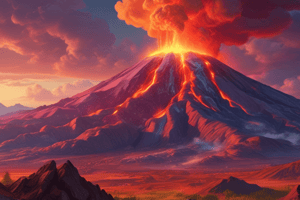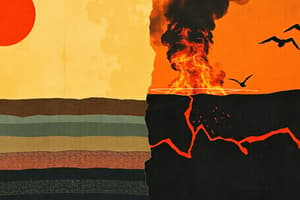Podcast
Questions and Answers
What is the name for the 18-mile thick layer of solid rock that we live on?
What is the name for the 18-mile thick layer of solid rock that we live on?
- Crust (correct)
- Magma
- Ocean
- Plate
What can happen when two of the Earth's plates move together?
What can happen when two of the Earth's plates move together?
- Creation of magma
- Extinction
- Formation of a volcano (correct)
- Stagnation
What causes the gas bubbles inside magma to grow bigger?
What causes the gas bubbles inside magma to grow bigger?
- Movement of tectonic plates
- Interaction with air
- Heating from the Earth's core
- Release of pressure (correct)
Why does a volcano erupt according to the text?
Why does a volcano erupt according to the text?
What type of eruption is expected when the magma is runny and the gas can escape easily?
What type of eruption is expected when the magma is runny and the gas can escape easily?
Why is it important to know about the Earth's crust in order to understand volcanic eruptions?
Why is it important to know about the Earth's crust in order to understand volcanic eruptions?
What is the term used for the molten rock that flows from a volcano?
What is the term used for the molten rock that flows from a volcano?
Which term refers to the smallest pyroclasts thrown from a volcano?
Which term refers to the smallest pyroclasts thrown from a volcano?
What type of volcanoes are formed by runny lava spreading out over a wide area?
What type of volcanoes are formed by runny lava spreading out over a wide area?
Which volcano is an example of a strato-volcano?
Which volcano is an example of a strato-volcano?
What event formed Crater Lake in the United States?
What event formed Crater Lake in the United States?
Flashcards
What is the Earth's crust?
What is the Earth's crust?
The outermost solid layer of Earth, about 18 miles thick.
What results from plates moving together?
What results from plates moving together?
Volcano formation
What makes magma gas bubbles grow?
What makes magma gas bubbles grow?
Release of pressure
Why does a volcano erupt?
Why does a volcano erupt?
Signup and view all the flashcards
What eruption results from runny magma?
What eruption results from runny magma?
Signup and view all the flashcards
Why understand the Earth's crust?
Why understand the Earth's crust?
Signup and view all the flashcards
What is lava?
What is lava?
Signup and view all the flashcards
What is ash?
What is ash?
Signup and view all the flashcards
What are shield volcanoes?
What are shield volcanoes?
Signup and view all the flashcards
Strato-volcano example
Strato-volcano example
Signup and view all the flashcards
Crater Lake formation event?
Crater Lake formation event?
Signup and view all the flashcards
Study Notes
Earth's Crust and Volcanic Eruptions
- The 18-mile thick layer of solid rock that we live on is called the lithosphere.
- When two of the Earth's plates move together, they can collide and cause the Earth's surface to buckle, forming mountains or volcanoes.
- Gas bubbles inside magma grow bigger when the pressure on them decreases, causing them to expand.
- A volcano erupts when the pressure of the gas bubbles in the magma becomes too great, causing the magma to burst out of the ground.
- When magma is runny and gas can escape easily, a gentle eruption is expected.
- Knowing about the Earth's crust is important for understanding volcanic eruptions because it helps us understand the movement of tectonic plates and the formation of volcanoes.
- The term used for molten rock that flows from a volcano is lava.
- The smallest pyroclasts thrown from a volcano are called ash.
- Volcanoes formed by runny lava spreading out over a wide area are called shield volcanoes.
- Mount Fuji is an example of a strato-volcano.
- Crater Lake in the United States was formed by a massive volcanic eruption that caused the volcano to collapse.
Studying That Suits You
Use AI to generate personalized quizzes and flashcards to suit your learning preferences.




